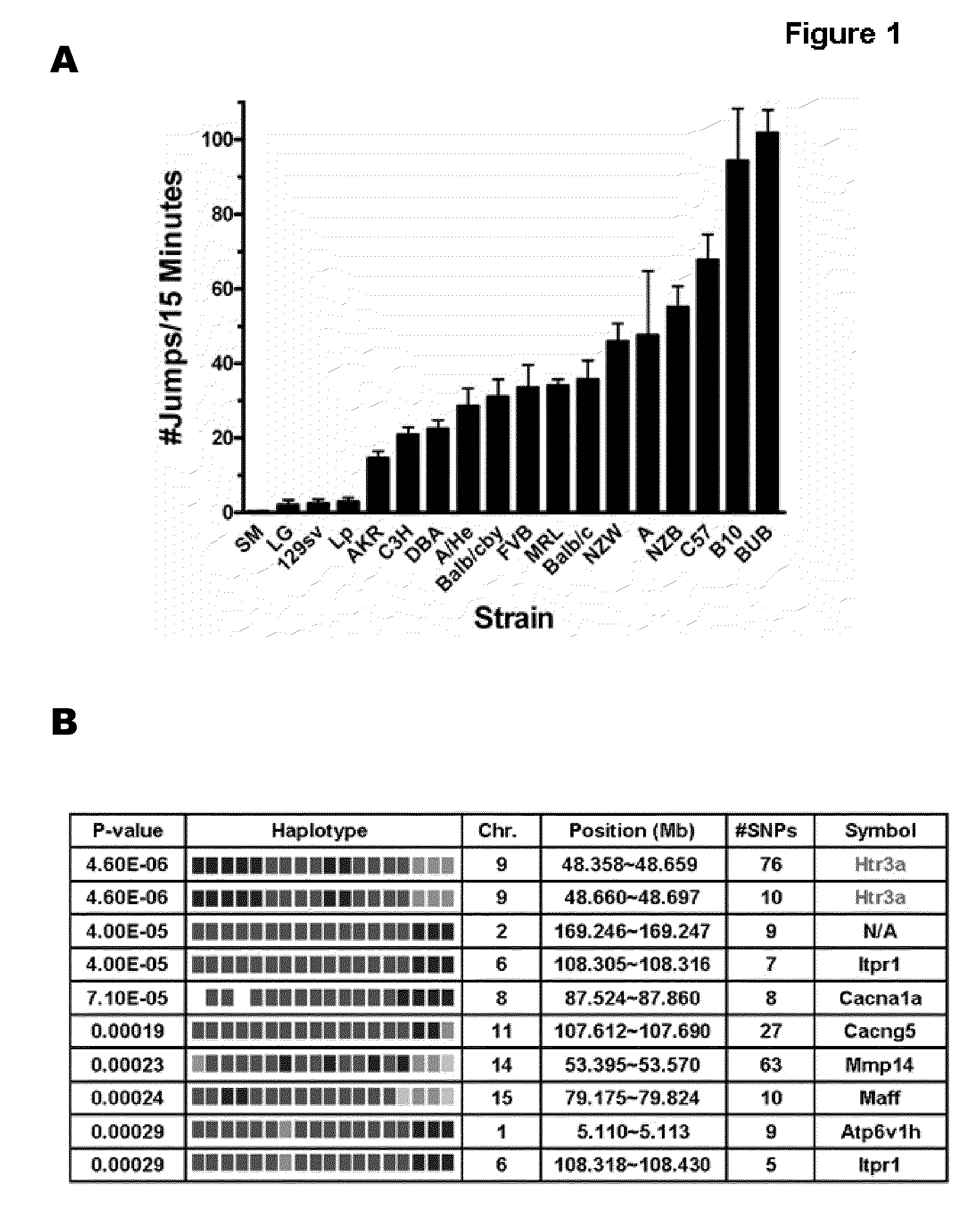Methods and Compositions for Treating or Preventing Narcotic Withdrawal Symptoms
- Summary
- Abstract
- Description
- Claims
- Application Information
AI Technical Summary
Benefits of technology
Problems solved by technology
Method used
Image
Examples
example 1
Genetic Variation within HTR3A Affects Morphine Dependence
[0159]Eighteen inbred strains were made physically dependent on morphine, an archetypical opioid narcotic, by administration over a 4-day period. Then, the jumping behavior precipitated by the administration of an opioid receptor antagonist (naloxone) to the dependent mice was measured. There were very large inter-stain differences in the withdrawal-induced jumping behavior; SM / J mice averaged only one jump in the 15 minute period following naloxone administration while BUB / BnJ mice jumped over 100 times under the same conditions (FIG. 1). Other investigators (Kest, B., et al., Pharmacol Biochem Behav, 2002. 73(4): p. 821-828) evaluated eight of these strains by a similar method, and a comparative Pearson correlation analysis of the data for the 8 common strains indicated that two studies yielded similar results (coefficient of 0.87, p=0.05).
[0160]Haplotype-based computational genetic mapping was used to analyze data from our...
example 2
5-HT3 Receptor Antagonist (Ondansetron) Decreases Naloxone Precipitated Withdrawal Behavior
[0164]To determine whether 5-HT3 receptor function affects opioid withdrawal, the effect of a selective 5-HT3 receptor antagonist (ondansetron) on withdrawal-associated jumping was assessed. Administration of ondansetron prior to measurement of naloxone-induced jumping significantly reduced this response in morphine-dependent C57BL / 6J mice in a dose-dependent fashion (FIG. 3A). In addition, simultaneous administration of ondansetron with each morphine dose during the 4-day protocol for establishing dependence diminished the naloxone-precipitated withdrawal response (FIG. 3B). The latter effect was unlikely to be due to the presence of residual ondansetron at the time of the dependence measurement since a 1 mg / kg dose was not able to effectively inhibit withdrawal when given acutely, and approximately 5 half-lives of the drug had passed in the time between the last dose of ondansetron and the n...
example 3
Ondansetron Treatment Reduces Morphine Dependence Related Hyperalgesia
[0167]The spontaneous hyperalgesia observed in humans and mice after chronic exposure to opioids, which is referred to as opioid-induced hyperalgesia (Angst, M. S. and J. D. Clark, Anesthesiology, 2006. 104(3): p. 570-587), is another measure of physical dependence (Chu, L. F et al., J Pain, 2006. 7(1): p. 43-48; Kayan, S., et al., J Pharmacol Exp Ther, 1971. 177(3): p. 509-513; Von Voigtlander, P. F. and R. A. Lewis, J Pharmacol Methods, 1983. 10(4): p. 277-282). In the present experiments, chronic morphine treatment caused hyperalgesia in C57BL / 6J mice. Sensitization to a mechanical stimulus provides a robust degree of sensitization (Liang, D. Y., et al., Anesthesiology, 2006. 104(5): 1054-1062). Ondansetron administration had no effect on pain sensitivity in control mice that were not treated with morphine, but reversed the hyperalgesia that developed during morphine abstinence (FIG. 4). Taken together, these e...
PUM
| Property | Measurement | Unit |
|---|---|---|
| Mass | aaaaa | aaaaa |
| Mass | aaaaa | aaaaa |
| Mass | aaaaa | aaaaa |
Abstract
Description
Claims
Application Information
 Login to View More
Login to View More - R&D
- Intellectual Property
- Life Sciences
- Materials
- Tech Scout
- Unparalleled Data Quality
- Higher Quality Content
- 60% Fewer Hallucinations
Browse by: Latest US Patents, China's latest patents, Technical Efficacy Thesaurus, Application Domain, Technology Topic, Popular Technical Reports.
© 2025 PatSnap. All rights reserved.Legal|Privacy policy|Modern Slavery Act Transparency Statement|Sitemap|About US| Contact US: help@patsnap.com



